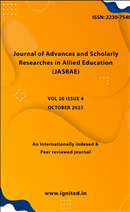Antioxidant and cytotoxic effects of 2-(3,4-dimethoxyphenyl)-3-(4-fluorophenyl)-5,7-dimethoxy-4H-chromen-4-one (a rutin derivative)
Keywords:
Rutin derivative, Antioxidant activity, Cytotoxic effects, DPPH assay, Hep-G2 cells, Flavonoid pharmacologyAbstract
This study investigates the antioxidant and cytotoxic effects of 2-(3,4-dimethoxyphenyl)-3-(4-fluorophenyl)-5,7-dimethoxy-4H-chromen-4-one (compound A), a derivative of rutin, a well-known flavonoid with antioxidant properties. The antioxidant activity of compound A was evaluated using the 2,2-diphenyl-1-picrylhydrazyl (DPPH) assay, while its cytotoxic effects were assessed using the 3-(4,5-dimethylthiazol-2-yl)-2,5-diphenyltetrazolium bromide (MTT) assay on Hep-G2 cells, a human liver cancer cell line.In the DPPH assay, compound A demonstrated dose-dependent antioxidant activity, with increasing concentrations leading to higher percentage inhibition of DPPH radicals. At concentrations ranging from 15 to 240 mg/ml, compound A exhibited significant antioxidant effects, with percentage inhibition values ranging from 10% to 70%. These results suggest that compound A possesses potent antioxidant properties, which could be attributed to its structural similarity to rutin.Conversely, in the MTT assay, compound A displayed dose-dependent cytotoxic effects on Hep-G2 cells. At lower concentrations (15-60 mg/ml), compound A induced cell death, as evidenced by low percentage cell viability values ranging from 4% to 22%. However, at higher concentrations (120-240 mg/ml), compound A promoted cell survival, with percentage viability values increasing up to 52%. This biphasic effect suggests that compound A exhibits both cytotoxic and cytoprotective effects on Hep-G2 cells, depending on the concentration range.Overall, our findings indicate that compound A possesses dual antioxidant and cytotoxic properties, making it a promising candidate for further investigation as a potential therapeutic agent against oxidative stress-related diseases and cancer. Further studies are warranted to elucidate the underlying mechanisms of action and to evaluate the efficacy and safety of compound A in preclinical and clinical settings.
References
Harvey, A. L., Edrada-Ebel, R. & Quinn, R. J. The re-emergence of natural products for drug discovery in the genomics era. Nat. Rev. Drug Discov. 14, 111–129 (2015).
Newman, D. J. &Cragg, G. M. Natural products as sources of new drugs from 1981 to 2014. J. Nat. Prod. 79, 629–661 (2016).
Nabavi, S.M.; Samec, D.; Tomczyk, M.; Milella, L.; Russo, D.; Habtemariam, S.; Suntar, I.; Rastrelli, L.; Daglia, M.; Xiao, J.; et al. Flavonoid biosynthetic pathways in plants: Versatile targets for metabolic engineering. Biotechnol. Adv. 2018.
Scarano, A.; Chieppa, M.; Santino, A. Looking at Flavonoid Biodiversity in Horticultural Crops: A Colored Mine with Nutritional Benefits. Plants 2018, 7, 98.
Imani A, Maleki N, Bohlouli S, Kouhsoltani M, Sharifi S, MalekiDizaj S. Molecular mechanisms of anticancer effect of rutin. Phytotherapy Research. 2021 May;35(5):2500-13.
Qu X, Zhao H, Wu D, Zhao L, Lu K, Teng Y. Synthesis and Biological Evaluation of the novel Antioxidant Agent Quercetin Derivatives. In3rd International Conference on Material, Mechanical and Manufacturing Engineering (IC3ME 2015) 2015 Aug (pp. 505-509). Atlantis Press.
Vishwakarma M, Piddini E. Outcompeting cancer. Nature Reviews Cancer. 2020 Mar 1;20(3):187-98.
Siegel RL, Miller KD, Wagle NS, Jemal A. Cancer statistics, 2023. Ca Cancer J Clin. 2023 Jan 12;73(1):17-48.
Muhammad N, Usmani D, Tarique M, Naz H, Ashraf M, Raliya R, Tabrez S, Zughaibi TA, Alsaieedi A, Hakeem IJ, Suhail M. The role of natural products and their multitargeted approach to treat solid cancer. Cells. 2022;11(14):2209.
Yuan M, Zhang G, Bai W, Han X, Li C, Bian S. The role of bioactive compounds in natural products extracted from plants in cancer treatment and their mechanisms related to anticancer effects. Oxidative Medicine and Cellular Longevity. 2022;2022.
Ekaette I, Saldaña MD. Ultrasound processing of rutin in food-grade solvents: Derivative compounds, antioxidant activities and optical rotation. Food Chemistry. 2021;344:128629.
Choi SS, Park HR, Lee KA. A comparative study of rutin and rutin glycoside: antioxidant activity, anti-inflammatory effect, effect on platelet aggregation and blood coagulation. Antioxidants. 2021;10(11):1696.









